The Importance of Push Lawn Mowers in Landscaping
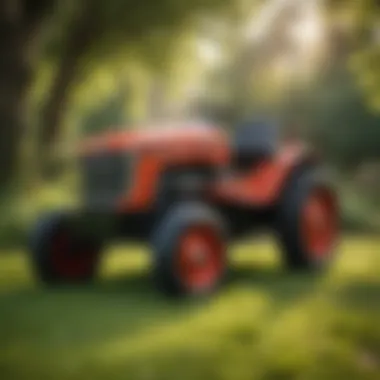
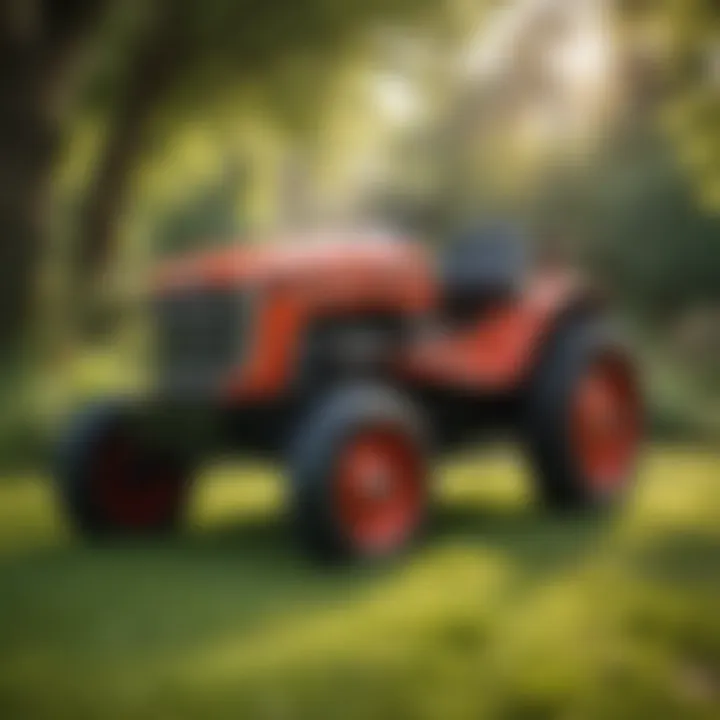
Intro
In the world of landscaping, achieving a perfectly manicured lawn is more than just aesthetics—it's a dance of techniques, tools, and practices. Among these tools, professional push lawn mowers hold a special place. These machines, often overlooked in favor of larger, more powerful counterparts, play a crucial role in both maintaining and enhancing the beauty of gardens, parks, and other green spaces. This article will unpack the growing importance of these mowers, traversing their rich history, illustrating their technological advancements, and demonstrating how they contribute to sustainable practices.
Topic Overview
Definition and Importance
First off, what exactly is a push lawn mower? It's a portable machine designed for cutting grass, commonly powered by human effort. Unlike its ride-on siblings, the push mower demands a bit more physical engagement but, as many experienced landscapers will attest, it allows for a level of precision that larger machines might sacrifice.
The importance of professional push lawn mowers extends beyond merely trimming grass. They serve as a symbol of meticulous care in landscaping—a device that emphasizes the hands-on approach many landscapers favor, promoting a closer relationship with the land. This level of engagement is increasingly vital in our era, as more professionals seek environmentally friendly and sustainable gardening practices.
Brief History and Evolution
The roots of lawn mowers can be traced back to the early 19th century, with Edward Budding's invention around 1830. His design, primarily for sports grounds, was a significant leap forward in garden maintenance technology. Over the years, these tools have evolved remarkably. The push-type mower has seen enhancements in blade design, materials, and ergonomics. From wooden wheels to modern robust designs made with high-grade plastics and alloys, the evolution is nothing short of spectacular. Nowadays, they come equipped with features like adjustable cutting heights and even eco-friendly designs that reduce noise and emissions when cutting grass, aligning with current environmental standards.
"The art of lawn care starts with the choice of tools, and professional push mowers remain essential for both novice and experienced landscapers."
Key Techniques and Innovations
Sustainable Farming Practices
Given their manual nature, push mowers offer a unique bump in sustainable gardening. They are quieter, making them perfect for residential areas and public parks where noise pollution can be a concern. Additionally, these machines do not rely on gasoline; hence, their operation doesn’t contribute to fuel emissions. These facets not only benefit the operators but also contribute positively to the environment.
Other sustainable practices involve proper seasonal maintenance of the mower itself. Regularly sharpening blades, cleaning the deck, and ensuring the wheels are in good condition can prolong the lifespan of these machines.
Advanced Agronomic Technologies
Innovation does not stop at construction but extends to technology adoption. Modern professional push lawn mowers are now being equipped with advancements such as smart sensors and GPS technology. With the right accessories, certain models can provide real-time feedback, helping operators to optimize mowing patterns and ultimately enhance the quality of turf management. Such developments streamline not only the mowing process but also help in maintaining the health of the grass.
Practical Applications
Step-by-Step Guides
For the novice gardener or the bustling landscaper, here’s a quick guide to using a professional push mower effectively:
- Prepare the Lawn: Clear any debris—sticks, toys, or rocks—that could interfere with mowing.
- Set the Height: Adjust the mower’s cutting height according to the type of grass and desired length.
- Start Mowing: Begin mowing around the perimeter of the lawn to establish a border, then fill in the interior using overlapping passes.
- Maintain a Straight Path: Keep a steady pace while guiding the mower; it’s better to focus on straight lines for cleaner cuts.
- Post-Mow Care: After mowing, check the mower for any maintenance needs.
Case Studies or Real-World Examples
Consider a local park that implemented the use of professional push mowers as part of their landscaping strategy. The results were striking. By reducing noise complaints and embracing sustainability, park officials found they could enhance community engagement during maintenance hours. Patrons reported a more enjoyable experience, which in turn fostered more community involvement in park events.
Such examples underscore that the right tools can create ripples of positive change, transforming common spaces into lush, inviting environments.
Through the lens of modern landscaping, professional push lawn mowers have emerged as indispensable companions—integral not just to lawn care but to the broader conversation on sustainability and ecological stewardship.
Prelude to Professional Push Lawn Mowers
In the realm of landscaping, the importance of professional push lawn mowers cannot be understated. They represent not only a means of maintaining aesthetics but also an essential tool for promoting health and sustainability in green spaces. These mowers are designed with precision and intelligence, specifically catered to the diverse needs of both professional landscapers and avid gardeners alike. The rising trend towards eco-friendliness and sustainability in agricultural practices pushes the spotlight on push lawn mowers, as they significantly contribute to reducing environmental footprints while delivering impeccable lawn care.
Definition and Purpose
At their core, professional push lawn mowers serve a fundamental purpose: to provide a clean, even cut to grass and maintain healthy turf. Different from their riding counterparts, push mowers require physical effort from the user, which inherently fosters a stronger connection with the task at hand. This aspect appeals particularly to those who enjoy being part of the gardening process. Furthermore, these mowers are often quieter and more environmentally friendly, with many models available in electric formats, making them suitable for residential areas. The precision of these machines allows for specific cutting heights, enabling users to tailor their mowing experiences based on the type of turf or the look they want to achieve.
Historical Context
The history of lawn mowers is as rich as the earth they work upon. The first push mower was invented in the early 19th century by Edwin Beard Budding in England. Budding’s design was born out of necessity for an efficient way to trim the grass in parks and sports grounds. Before this innovation, grass was typically managed using manual scythes, which demanded considerable strength and was time-consuming. As the landscape of lawns transformed from simple gardens to elaborate estates, so did the technology.
Over the decades, push mowers evolved in design, function, and efficiency. By the 20th century, the introduction of rotary mowers fundamentally changed lawn maintenance. Today, professional push mowers come equipped with advanced features that make them not only user-friendly but also more effective than their predecessors. The journey of push mowers mirrors the broader evolution within landscaping, highlighting the sector’s ongoing emphasis on efficiency, responsibility, and sustainable practices.
"Understanding the historical context of push lawn mowers enables us to appreciate their ongoing role in contemporary landscaping practices."
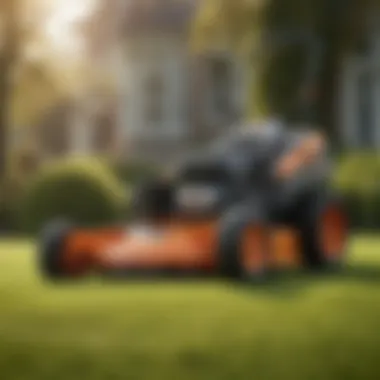
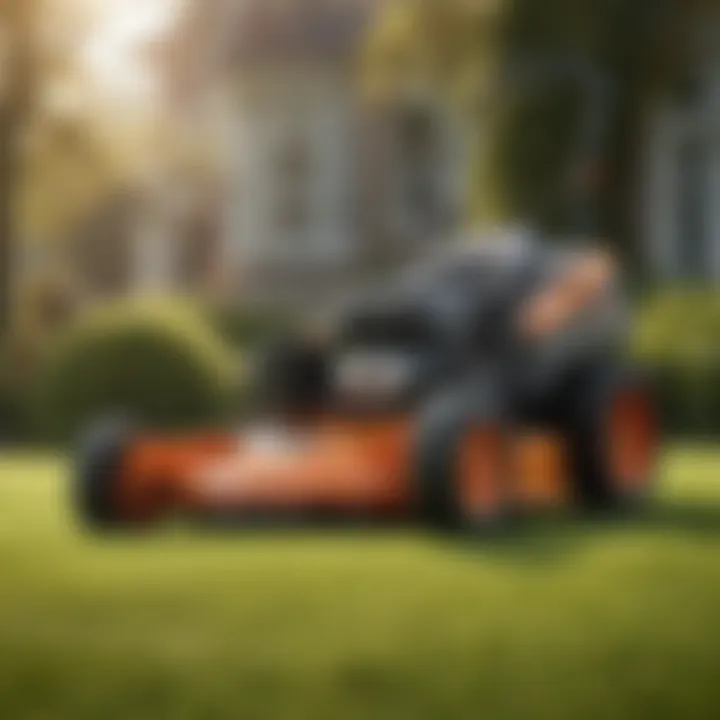
Understanding Different Types of Push Lawn Mowers
Grasping the different types of push lawn mowers is crucial for anyone involved in modern landscaping. Each type offers specific functionalities and unique advantages, catering to various needs and preferences. Whether you’re a seasoned horticulturist or a DIY enthusiast, having a precise understanding of these options can significantly affect your mowing experience and the aesthetic outcome of your landscape. Let’s break it down further.
Reel Mowers
Reel mowers often bring to mind that nostalgic image of a lush lawn cut in perfect uniformity. Built around a simple yet effective cutting system, these mowers employ a set of rotating blades that work like a pair of scissors. This design allows for a clean cut which promotes healthier grass growth, making it a favored choice among many professional landscapers.
One major advantage is their quiet operation. It’s like a peaceful morning in the garden, where the only sounds are birds singing and perhaps the gentle whirr of the blades at work. This can be an appealing aspect, particularly in residential areas where noise pollution is a concern. Plus, since reel mowers don’t require fuel, they're often considered more environmentally friendly. Nonetheless, they're not without their drawbacks. Reel mowers require regular maintenance to keep the blades sharp, and the cutting height can be somewhat restrictive, working best on shorter grasses.
Rotary Mowers
In contrast, rotary mowers have made waves in the landscaping world. Their versatility shines through especially when managing larger or more uneven areas. Unlike reel mowers, rotary varieties utilize a single horizontal blade that rotates, effectively chopping through even thicker grass. This aggressive style gives landscapers an edge, cutting through tough terrain like it’s going out of style.
However, it’s important to note that mowing too low can damage the grass and leave it vulnerable to pests. Users should aim for a balance, maintaining an appropriate height for the type of grass in their yards. Rotary mowers also come in various models, from manual push types to more advanced powered versions. This flexibility allows users to choose a mower that aligns with both their financial and physical capabilities.
Electric vs. Gas Models
The debate between electrical and gas models can resemble an age-old conflict, with passionate advocates on both sides. Electric mowers are notable for their ease of use, needing little maintenance and offering quiet operation. There’s a certain delight in quickly plugging in your mower and getting going, without the trouble of mixing fuel or worrying about fumes. This makes electric mowers particularly appealing for residential gardens, where noise can disturb the tranquility of the setting.
On the flip side, gas mowers boast power and performance. With the ability to cover larger areas without the constraints of battery life, gas mowers are often the weapon of choice for professionals who need efficiency and strength. However, they require more significant upkeep. The debate also extends beyond practicality—it's about personal preference and values. Some gardeners may prioritize eco-friendliness, leaning towards electric models, while others might favor the resilience and ruggedness of gas-powered mowers.
With all these types to consider, the choice ultimately boils down to one's specific landscaping needs, budget, and personal preferences. Each mower type brings something unique to the table, shaping the landscape experience for both professionals and enthusiasts alike.
Functional Advantages of Push Lawn Mowers
Understanding the functional advantages of push lawn mowers is vital in appreciating their place in modern landscaping. These machines are not just tools; they're companions in the quest for maintaining lush and healthy lawns. Professional landscapers, novice gardeners, and enthusiasts alike are drawn to the unique features that push lawn mowers offer. Below, we'll delve into three major advantages: precision cutting mechanism, enhanced maneuverability, and environmental impact reduction.
Precision Cutting Mechanism
One of the standout features of push lawn mowers is their precision cutting mechanism. Unlike their ride-on counterparts, these manual machines provide a hands-on approach to lawn care. The blades of a push mower, particularly the reel mowers, engage in a scissor-like action, ensuring grass is cut cleanly. This clean cut is essential because it promotes healthier grass growth and reduces the likelihood of diseases.
For instance, consider the meticulous attention to detail a professional landscaper employs when mowing. They often favor reel mowers to achieve that immaculate finishing touch, which, in turn, enhances the aesthetic appeal of a property. Furthermore, with height adjustments available on most models, users can keep grass at optimal lengths tailored to the specific grass type or season.
Did you know? The precision offered by push lawn mowers can also save time during aftercare, such as dethatching and aerating, since clean cuts leave fewer clippings behind to clog up those processes.
Enhanced Maneuverability
When it comes to tight spaces or uneven ground, push lawn mowers excel in their maneuverability. Landscapers often find themselves working in areas where larger machinery simply won't fit. With a lightweight design and the ability to easily navigate around obstacles like flower beds, trees, and garden decorations, push mowers are an asset.
For instance, a landscaper might be faced with a small garden path flanked by native plants. Using a push mower allows them to make quick, efficient passes without risking damage to the surrounding flora. Their compact size means they can also be transported with ease, whether it's to the next job site or to store away in a tight garage.
Furthermore, the workout that comes with using a push mower shouldn’t be overlooked. This physical engagement fosters a deep connection with the land while promoting health benefits for the user.
Environmental Impact Reduction
In today’s eco-conscious world, many are turning their attention towards sustainable practices in landscaping. Push lawn mowers present a greener alternative to gas-powered mowers. They work without harmful emissions, contributing to a cleaner environment. This aspect becomes increasingly significant in urban areas, where air quality is often compromised.
Using a push lawn mower also encourages the practice of mulching. Many models feature a built-in mulching function that finely cuts grass clippings, allowing them to decompose on the lawn. This natural fertilization process not only enriches the soil but also reduces the need for chemical fertilizers, fostering healthier ecosystems.
"By employing push lawn mowers, we aren’t just cutting grass; we are nurturing our surroundings and promoting a sustainable landscaping practice."
As we look forward, the functional advantages of push lawn mowers reveal a wealth of benefits. Their precision, agility, and environmental friendliness make them indispensable tools for anyone seeking not just to maintain but enhance their landscaping endeavors.
Market Analysis of Professional Push Lawn Mowers
Understanding the market dynamics surrounding professional push lawn mowers is crucial for both consumers and professionals in the landscaping industry. The market is a mosaic of various brands, technologies, and price points, reflecting the diverse needs of users. An effective analysis not only helps in identifying leading brands but also sheds light on the financial considerations that play into purchasing decisions, as well as the technological advancements on the horizon.
Leading Brands and Manufacturers
When it comes to push lawn mowers, some brands stand out in terms of quality, innovation, and reputation. Popular manufacturers like Honda, Toro, and Cub Cadet dominate this space.
- Honda is known for its reliability and robust engineering. Users often praise their mowers for intuitive features, such as easy-start systems and sturdy build quality.
- Toro focuses on commercial-grade performance, offering high-powered models tailored for professional landscapers.
- Cub Cadet specializes in affordability without compromising on quality, making it a favorite for smaller landscaping businesses.
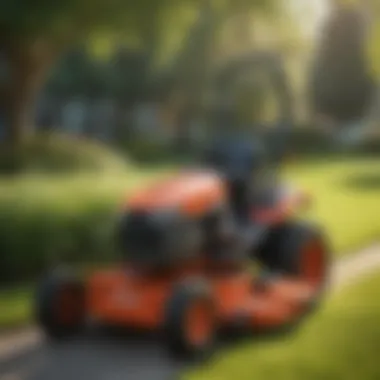

Each brand has carved out its own niche, ensuring a competitive market where advancements flow rapidly. Reviews and case studies often provide insights into user satisfaction, durability, and service experiences, fueling informed consumer decisions.
Price Range Variability
The price of professional push lawn mowers varies widely, reflecting differences in features and brand reputation. On one end, you might find basic reel mowers priced below $200, which serve well for small residential lawns. Conversely, high-end rotary mowers can easily exceed $1,500, packed with advanced technology and features that cater to landscaping professionals.
Key factors influencing price include:
- Features: Models that include self-propelling capabilities or advanced cutting technology generally command higher prices.
- Build Quality: Higher-priced mowers often come with durable materials that increase longevity.
- Service Plans: Some brands offer extended warranties or service plans, affecting initial purchase costs.
Knowing where a mower sits on this spectrum is vital for budgets, allowing users to weigh cost against features and warranty options.
Innovative Features in New Models
As technology evolves, so too do the features found in modern push lawn mowers. Notable innovations include:
- Smart Mowers: These come equipped with Bluetooth connectivity, allowing users to control settings and maintenance reminders via a smartphone app.
- Variable Speed Control: This feature enables users to adjust the speed of the mower’s movement, making it easier to handle diverse lawn conditions.
- Eco-Friendly Options: More brands are leaning toward battery-powered models, reducing carbon footprints and offering quieter operations.
"Innovation in lawn care equipment doesn't just mean improved efficiency; it also points towards sustainable practices that can reshape our landscapes for the better."
The integration of user feedback into product development continues to drive these advances, ensuring that manufacturers keep pace with the needs of modern landscapers. As such, choosing a mower with the right innovations can drastically enhance performance and ease of use.
Maintenance and Care for Optimal Performance
Proper maintenance and care of professional push lawn mowers is not just a best practice; it is essential for ensuring these machines operate efficiently and last for years. Neglecting routine maintenance can lead to diminished cutting performance, erratic operation, and ultimately, premature wear and tear. Understanding the nuances of mower care can save both time and money, while also promoting a healthier lawn.
When you think about it, a well-maintained mower is like a well-tuned instrument. It performs better, feels smoother, and gives you the results you expect. Regular upkeep can prevent small issues from snowballing into significant problems that require costly repairs or replacements.
Cleaning and Storage Guidelines
Cleaning your lawn mower after each use is remarkably crucial. Grass clippings, mud, and debris can accumulate under the deck and around the blades, leading to corrosion and inefficient cutting. After mowing, let the mower cool down for a few minutes, then:
- Remove Grass Clippings: Using a plastic scraper or brush, carefully remove clippings from the underside of the mower deck. This prevents clogging and promotes airflow.
- Check for Debris: Inspect the area around the wheels and under the handle for any bits of grass or dirt that might've stuck during the job. A simple wipe down can work wonders.
- Wash the Mower: Occasionally, it is wise to clean the entire machine. A damp cloth and soapy water can do the trick. Avoid getting water into the engine, and be sure to dry it thoroughly afterward.
- Store Properly: When the mowing season ends, store the mower in a dry location. Use a cover to protect it from dust and moisture, which can lead to rust and other issues. Keeping it in a shed or garage is preferable to leaving it outdoors, where environmental factors can degrade its performance.
Storing your mower properly, alongside the right cleaning practices, can perpetuate its efficiency.
Sharpening and Replacing Blades
The blades of your push lawn mower are its most crucial components. Dull blades tear grass rather than cutting it cleanly, which may lead to an unhealthy lawn susceptible to disease. Regular sharpening is necessary—typically at least once a season or more often if you mow frequently.
Consider these steps for sharpening and replacing blades:
- Inspection: Each time you clean the mower, inspect the blades for nicks, dents, or dullness.
- Sharpening: For blade sharpening, you can either use a file or a sharpening stone. If you're unsure how to do it, many local shops can help, or you can watch online tutorials. Maintain a 30-degree angle while sharpening to preserve the blade's integrity.
- Replacement: If the blade is beyond repair or shows significant wear, it’s time to replace it. Most hardware stores provide compatible replacement blades. Maintain the same specifications as the original for the best results.
- Installation: Follow the manufacturer's guidelines to properly install a new blade. A secure fit ensures safety and effectiveness.
"An efficient mower means not just a beautiful lawn but also a more enjoyable mowing experience."
In summary, the life of a professional push lawn mower directly ties with how well it is maintained and cared for. Proper cleaning, thoughtful storage, and regular blade care are the cornerstones of optimal performance. This diligence translates into stellar mowing results and can foster a greener, healthier landscape.
User Experiences and Professional Insights
Case Studies from Landscapers
Understanding how professional push lawn mowers function in real-world scenarios is crucial for grasping their impact on landscaping practices. Landscapers often share their insights through case studies that highlight practical applications and outcomes of using these machines. One notable example comes from a landscape maintenance company in California, where the crew replaced aged gas mowers with newer electric push mowers. This switch not only decreased fuel costs but also minimized noise pollution during early morning lawn care, thus enhancing neighborhood relations.
Moreover, a landscape architect from Texas reported how the precision cutting of push mowers enabled him to create intricate patterns on a client's lawn. Traditional gas mowers would often leave uneven patches, but the light maneuverability of push mowers allowed for a level of detail that left the client impressed.
Several landscapers appreciate features such as adjustable cutting heights and easy blade replacement mechanisms, which have made their workflows more efficient. Flexibility in mower settings permits them to tailor cuts according to specific grass types and client preferences, which is invaluable in maintaining the aesthetic and health of various landscapes. In these case studies, the common thread is the observed benefit of switching to push mowers. Improved lawn quality, reduced maintenance costs, and enhanced client satisfaction are frequently cited as outcomes of this transition.
Consumer Feedback and Reviews
The voice of the consumer plays a significant role in shaping the narrative around professional push lawn mowers. Online reviews on platforms like Reddit and specialized gardening forums reveal diverse experiences that shed light on their practicality in the real world. Users often share their thoughts on different brands and models, highlighting both pros and cons.
For instance, many consumers rave about the durability of the Honda HRX217VKA, specifically mentioning its strong steel deck and powerful cutting system. Owners appreciate how effortlessly it accommodates different terrains, making it suitable for both residential lawns and more challenging landscape designs. Some reviews even touch on the mower's self-propelling feature, which eases the workload, thus reducing fatigue during long mowing sessions.
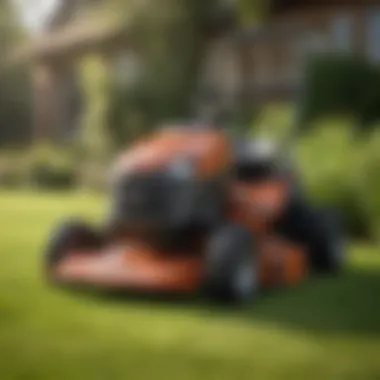
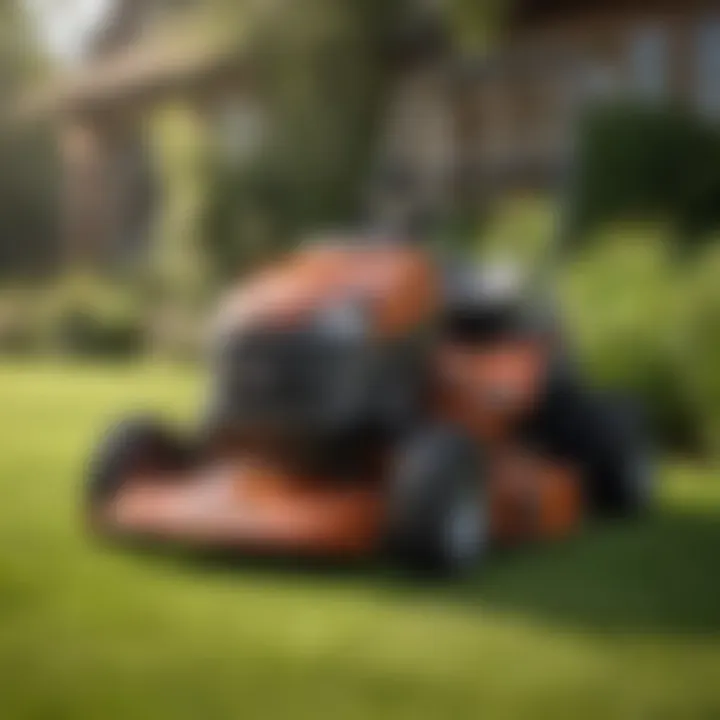
On the flip side, there are also discussions around maintenance challenges. Several users have pointed out that while the lightweight design of the Sun Joe MJ401E is great for maneuvering, its build may not withstand rigorous usage over time compared to heavier models.
"You think you're saving weight with the Sun Joe. But show it a rocky terrain and it might buckle under pressure," one user commented on Reddit. This sentiment aligns with a broader understanding that while some mowers excel in maneuverability, others may torch durability, particularly for professional landscaping use.
By weaving together various user experiences and professional insights, this article synthesizes a wealth of information that caters specifically to those in the agriculture and landscaping sectors. It emphasizes not only the practical use of push lawn mowers but also the considerations necessary when choosing the right equipment for one’s specific needs.
The Role of Push Lawn Mowers in Sustainable Landscaping
In the evolving landscape of green practices, professional push lawn mowers stand out as pivotal tools for eco-conscious land management. Their design and operation not only enhance the aesthetics of properties but also contribute significantly to ecological well-being. As urban areas increase and natural spaces diminish, the role of these mowers in preserving a healthy ecosystem grows ever more crucial.
The beauty of using push lawn mowers lies in their gentle touch on the environment. Unlike their gas-powered counterparts, push mowers emit no pollutants, fostering cleaner air and reducing noise levels. This aspect is particularly beneficial in residential neighborhoods where serenity matters. Engaging with push lawn mowers means opting for a cutting approach that encourages sustainable landscaping practices.
Benefits to Soil Health
When we talk about the health of the soil, we are addressing the foundation of robust plant life. Lawn mowers that are pushed manually often exhibit a lighter footprint when compared to heavier gas mowers. This reduced weight minimizes soil compaction, allowing essential nutrients and water to penetrate deeper into the ground.
Moreover, maintaining a regular mowing schedule with these push mowers promotes the ideal height for grass. Keeping grass at a longer length promotes rooting depth, improves drought resistance, and enhances nutrient uptake. Regarding the clippings, they can serve as natural mulch. Leaving them behind after mowing helps retain moisture and provides a source of nitrogen as they decompose. This practice not only enriches the soil but also reduces the need for chemical fertilizers, contributing to a healthier lawn over time.
Encouraging Biodiversity Practices
Biodiversity is a term that might sound technical, yet it's vital for any landscaping endeavor. Push lawn mowers encourage a more diverse ecosystem by promoting practices that benefit various plant species, insects, and wildlife.
Using reel mowers or electric push mowers can lead to the preservation of different grass types and blooming wildflowers by adopting a more selective mowing practice. Instead of trimming grass down to a uniform height, the diversity in cutting helps maintain essential flowering plants. This not only draws bees, butterflies, and other pollinators, but it also supports a balanced ecosystem. Furthermore, as the mower has less impact on the earth around it, it paves the way for wildlife to thrive. From birds nesting in longer grasses to beetles harboring in thatch, these mowers contribute significantly to the overall health of gardens and yards.
The adoption of push lawn mowers in landscaping can catalyze positive environmental changes, blending aesthetics with nature’s needs.
When planning for sustainable landscaping, it’s refreshing to see that the tools we choose can directly influence the health of our environment. By prioritizing professional push lawn mowers, homeowners and landscapers alike are not just cutting grass—they are nurturing life in all its forms.
Future Trends in Lawn Mowing Technology
As we look to the horizon, the landscape of lawn mowing technology is evolving remarkably. The integration of new technologies not only enhances the efficiency of push lawn mowers but also aligns with modern landscaping principles that demand sustainability and adaptability. Understanding these trends provides meaningful insights into how homeowners and professionals alike can leverage advancements to maintain vibrant, healthy lawns while minimizing their ecological footprint.
Emerging Technologies
The forefront of lawn care innovation includes automation and smart technologies that are rapidly transforming traditional mowing practices. One can't overlook how robotics are stepping into the limelight. Autonomous mowers, like those produced by Husqvarna and Robomow, are gaining traction. These devices operate efficiently with minimal human input, utilizing GPS and sensors to navigate lawns with precision. This enables a consistent cutting schedule while freeing up the user’s time for other tasks.
Moreover, data-driven lawn care is shaping how we approach maintenance. Mowers equipped with sensors gather data on grass health and soil conditions, providing insights that allow for tailored care. One example includes systems that automatically adjust cutting height based on the growth patterns of grass. Such innovations ensure optimal cutting without stress on the plant, ultimately fostering a healthier lawn.
The rise of electric and battery-operated models is also noteworthy. These mowers are quieter, more environmentally friendly, and require less maintenance than their gas counterparts. Consumers are turning to options from brands like EGO Power+ and Greenworks, which offer robust performance without the noise pollution and emissions associated with traditional gasoline engines.
"The combination of convenience and sustainability in lawn care technologies is not just a trend—it's a necessity for modern living."
Predictions for Landscape Maintenance
Looking ahead, it's clear that the prediction surrounding landscape maintenance will pivot around connectivity and smart technologies. Many anticipate a shift towards connected ecosystems of lawn care equipment that communicate with each other. Consider a scenario where your push mower can sync with your smartphone app, allowing for scheduling and reminders. This could generate alerts not only for mowing but also for necessary maintenance tasks like checking blade sharpness or fuel levels, ensuring optimal performance.
In addition, as urbanization continues, the trend towards vertical gardens and small-sized lawns is emerging. With these changes, traditional mowing practices will adapt. Innovations in mower design will need to cater to smaller, task-specific models that navigate tight spaces and perform efficiently. Brands may increasingly innovate towards compact and lightweight models, making them more accessible to urban homeowners.
Moreover, as awareness around sustainable practices grows, there will be an increased emphasis on biodegradable materials and recyclable components in mower manufacturing. This aligns perfectly with consumers' desire for environmentally responsible products, further driving the trend towards eco-friendly landscaping.
In summary, the future of lawn mowing technology is not just about pushing boundaries but also about integrating smart practices into everyday care. The evolution is rich with promise, indicating that the way we maintain our landscapes will increasingly lean towards sustainability, efficiency, and enhanced user experience.
Culmination
The role of professional push lawn mowers cannot be overstated in the contemporary landscaping scene. This article has traversed various aspects, highlighting not only the tools themselves but also the broader implications of these machines on landscape aesthetics and sustainability.
Recap of Key Points
Throughout our journey, we have outlined several important points:
- Definition and Purpose: Push lawn mowers are essential for maintaining a well-manicured lawn, providing both functional benefits and aesthetic appeal.
- Historical Evolution: Understanding the history of lawn mowers sheds light on their development and relevance in modern practices.
- Types of Mowers: The choice between reel and rotary mowers, along with electric and gas options, allows users to tailor their equipment to specific lawn care needs.
- Functional Advantages: Precision cutting, maneuverability, and lower environmental impact are just a few of the standout features that make push mowers a preferred choice among professionals.
- Market Analysis: The variance in price points and the emergence of innovative features reflect a dynamic market catering to diverse consumer needs.
- Maintenance Practices: Proper care ensures longevity and exceptional performance from lawn mowers, underscoring the need for regular upkeep.
- Sustainability: Push lawn mowers play a crucial role in promoting healthier soil and biodiversity, making them vital in today’s eco-conscious landscape management.
- Future Prospects: Keeping an eye on emerging technologies and trends helps stakeholders remain relevant and efficient in their methodologies.
Final Thoughts on Selection and Use
When it comes to selecting a push lawn mower, various factors should guide the decision-making process. Consider the size of your lawn, your budget, and the types of features that align with your specific needs. Additionally, take into account the availability of replacement parts and maintenance resources. This foresight ensures that the investment made is not just for today’s needs but also resonates over time.
Using these tools effectively also demands an understanding of appropriate mowing techniques, proper blade care, and timely mowing schedules to achieve the best results. Therefore, through informed selection and conscientious usage, landscape professionals and enthusiasts can not only enhance their lawn's appearance but also foster sustainable practices that contribute positively to our environment.
"The right tool can change the way you interact with your landscape, turning a chore into an art form."



